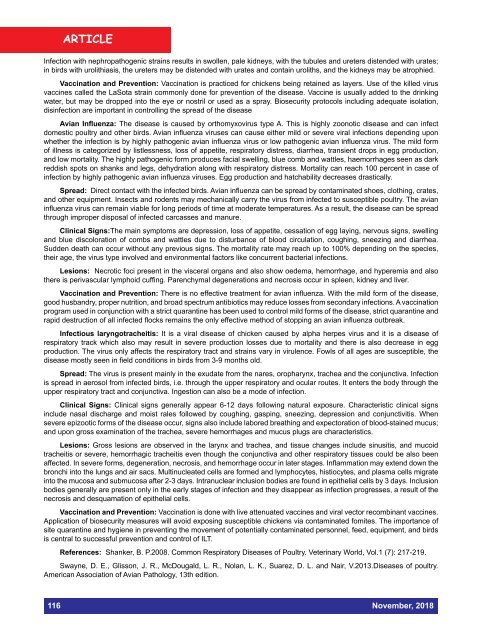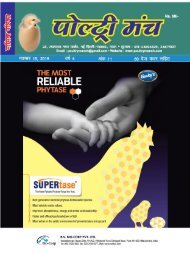November 2018 Punch PDF
Create successful ePaper yourself
Turn your PDF publications into a flip-book with our unique Google optimized e-Paper software.
ARTICLE<br />
Infection with nephropathogenic strains results in swollen, pale kidneys, with the tubules and ureters distended with urates;<br />
in birds with urolithiasis, the ureters may be distended with urates and contain uroliths, and the kidneys may be atrophied.<br />
Vaccination and Prevention: Vaccination is practiced for chickens being retained as layers. Use of the killed virus<br />
vaccines called the LaSota strain commonly done for prevention of the disease. Vaccine is usually added to the drinking<br />
water, but may be dropped into the eye or nostril or used as a spray. Biosecurity protocols including adequate isolation,<br />
disinfection are important in controlling the spread of the disease<br />
Avian Influenza: The disease is caused by orthomyxovirus type A. This is highly zoonotic disease and can infect<br />
domestic poultry and other birds. Avian influenza viruses can cause either mild or severe viral infections depending upon<br />
whether the infection is by highly pathogenic avian influenza virus or low pathogenic avian influenza virus. The mild form<br />
of illness is categorized by listlessness, loss of appetite, respiratory distress, diarrhea, transient drops in egg production,<br />
and low mortality. The highly pathogenic form produces facial swelling, blue comb and wattles, haemorrhages seen as dark<br />
reddish spots on shanks and legs, dehydration along with respiratory distress. Mortality can reach 100 percent in case of<br />
infection by highly pathogenic avian influenza viruses. Egg production and hatchability decreases drastically.<br />
Spread: Direct contact with the infected birds. Avian influenza can be spread by contaminated shoes, clothing, crates,<br />
and other equipment. Insects and rodents may mechanically carry the virus from infected to susceptible poultry. The avian<br />
influenza virus can remain viable for long periods of time at moderate temperatures. As a result, the disease can be spread<br />
through improper disposal of infected carcasses and manure.<br />
Clinical Signs:The main symptoms are depression, loss of appetite, cessation of egg laying, nervous signs, swelling<br />
and blue discoloration of combs and wattles due to disturbance of blood circulation, coughing, sneezing and diarrhea.<br />
Sudden death can occur without any previous signs. The mortality rate may reach up to 100% depending on the species,<br />
their age, the virus type involved and environmental factors like concurrent bacterial infections.<br />
Lesions: Necrotic foci present in the visceral organs and also show oedema, hemorrhage, and hyperemia and also<br />
there is perivascular lymphoid cuffing. Parenchymal degenerations and necrosis occur in spleen, kidney and liver.<br />
Vaccination and Prevention: There is no effective treatment for avian influenza. With the mild form of the disease,<br />
good husbandry, proper nutrition, and broad spectrum antibiotics may reduce losses from secondary infections. A vaccination<br />
program used in conjunction with a strict quarantine has been used to control mild forms of the disease, strict quarantine and<br />
rapid destruction of all infected flocks remains the only effective method of stopping an avian influenza outbreak.<br />
Infectious laryngotracheitis: It is a viral disease of chicken caused by alpha herpes virus and it is a disease of<br />
respiratory track which also may result in severe production losses due to mortality and there is also decrease in egg<br />
production. The virus only affects the respiratory tract and strains vary in virulence. Fowls of all ages are susceptible, the<br />
disease mostly seen in field conditions in birds from 3-9 months old.<br />
Spread: The virus is present mainly in the exudate from the nares, oropharynx, trachea and the conjunctiva. Infection<br />
is spread in aerosol from infected birds, i.e. through the upper respiratory and ocular routes. It enters the body through the<br />
upper respiratory tract and conjunctiva. Ingestion can also be a mode of infection.<br />
Clinical Signs: Clinical signs generally appear 6-12 days following natural exposure. Characteristic clinical signs<br />
include nasal discharge and moist rales followed by coughing, gasping, sneezing, depression and conjunctivitis. When<br />
severe epizootic forms of the disease occur, signs also include labored breathing and expectoration of blood-stained mucus;<br />
and upon gross examination of the trachea, severe hemorrhages and mucus plugs are characteristics.<br />
Lesions: Gross lesions are observed in the larynx and trachea, and tissue changes include sinusitis, and mucoid<br />
tracheitis or severe, hemorrhagic tracheitis even though the conjunctiva and other respiratory tissues could be also been<br />
affected. In severe forms, degeneration, necrosis, and hemorrhage occur in later stages. Inflammation may extend down the<br />
bronchi into the lungs and air sacs. Multinucleated cells are formed and lymphocytes, histiocytes, and plasma cells migrate<br />
into the mucosa and submucosa after 2-3 days. Intranuclear inclusion bodies are found in epithelial cells by 3 days. Inclusion<br />
bodies generally are present only in the early stages of infection and they disappear as infection progresses, a result of the<br />
necrosis and desquamation of epithelial cells.<br />
Vaccination and Prevention: Vaccination is done with live attenuated vaccines and viral vector recombinant vaccines.<br />
Application of biosecurity measures will avoid exposing susceptible chickens via contaminated fomites. The importance of<br />
site quarantine and hygiene in preventing the movement of potentially contaminated personnel, feed, equipment, and birds<br />
is central to successful prevention and control of ILT.<br />
References: Shanker, B. P.2008. Common Respiratory Diseases of Poultry. Veterinary World, Vol.1 (7): 217-219.<br />
Swayne, D. E., Glisson, J. R., McDougald, L. R., Nolan, L. K., Suarez, D. L. and Nair, V.2013.Diseases of poultry.<br />
American Association of Avian Pathology, 13th edition.<br />
116 <strong>November</strong>, <strong>2018</strong>





